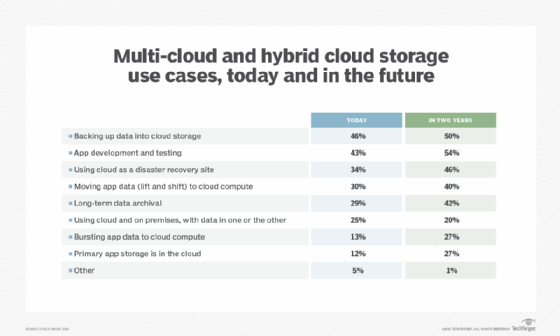AWS Outposts vs. Azure Stack vs. HCI
See how AWS Outposts vs. Microsoft Azure Stack hybrid cloud offerings work and where they can and cannot take the place of traditional hyper-converged infrastructures.
Giants Amazon and Microsoft offer cloud products and services that compete in areas usually reserved for the strengths that traditional hyper-converged infrastructure platforms bring to the enterprise IT table. These include hybrid cloud offerings AWS Outposts, which Amazon made generally available late last year, and Azure Stack from Microsoft.
An integrated hardware and software offering, Azure Stack is designed to deliver Microsoft Azure public cloud services to enable enterprises to construct hybrid clouds in a local data center. It delivers IaaS and PaaS for organizations developing web apps. By sharing its code, APIs and management portal with Microsoft Azure, Azure Stack provides a common platform to address hybrid cloud issues, such as maintaining consistency between cloud and on-premises environments. Stack is for those who want the benefits of a cloud-like platform but must keep certain data private due to regulations or some other constraint.
AWS Outposts is Amazon's on-premises version of its IaaS offering. Amazon targets AWS Outposts at those who want to run workloads on Amazon Web Services, but instead of in the cloud, do so inside their own data centers to better meet regulatory requirements and, for example, to reduce latency.
Let's delve deeper into AWS Outposts vs. Azure Stack to better see how they compete with each other and your typical hyper-converged infrastructure (HCI) deployment.

What is AWS Outposts?
AWS Outposts is Amazon's acknowledgment that most enterprise class organizations prefer hybrid cloud to a public cloud-only model. Amazon generally has acted solely as a hyperscale public cloud provider, leaving its customers' data center hardware needs for other vendors to handle. With AWS Outposts, however, Amazon is -- for the first time -- making its own appliances available for on-premises use.
AWS Outposts customers can run AWS on premises. They can also extend their AWS virtual private clouds into their on-premises environments, so a single virtual private cloud can contain both cloud and data center resources. That way, workloads with low-latency or geographical requirements can remain on premises while other workloads run in the Amazon cloud. Because Outposts is essentially an on-premises extension of the Amazon cloud, it also aims to ease the migration of workloads between the data center and the cloud.
What is Microsoft Azure Stack?
Although initially marketed as simply a way to host Azure services on premises, Azure Stack has evolved into a portfolio of products. The three products that make up the Azure Stack portfolio include Azure Stack Edge, Azure Stack Hub and Azure Stack HCI.
Azure Stack Edge is a cloud-managed appliance that enables you to run managed virtual machine (VM) and container workloads on premises. While this can also be done with Windows Server, the benefit to using Azure Stack Edge is workloads can be managed with a common tool set, whether they're running on premises or in the cloud.
Azure Stack Hub is used for running cloud applications on premises. It's mostly for situations in which data sovereignty is required or where connectivity isn't available.
As its name implies, Azure Stack HCI is a version of Azure Stack that runs on HCI hardware.
AWS Outposts vs. Azure Stack vs. HCI
To appreciate how AWS Outposts competes with traditional HCI, consider common HCI use cases. HCI is often used as a virtualization platform. While AWS Outposts will presumably be able to host Elastic Compute Cloud virtual machine instances, the bigger news is that Amazon is preparing to release a VMware-specific version of Outposts in 2020. The VMware Cloud on AWS Outposts will allow a managed VMware software-defined data center to run on the Outposts infrastructure.
Organizations are also increasingly using HCI as a disaster recovery platform. While Amazon isn't marketing Outposts as a DR tool, the fact that Outposts acts as a gateway between on-premises services and services running in the Amazon cloud means the platform will likely be well positioned as a DR enabler.
Many organizations have adopted hyper-converged systems as a platform for running VMs and containers. Azure Stack Edge may end up displacing some of those HCIs if an organization is already hosting VMs and containers in the Azure cloud. As for Azure Stack Hub, it seems unlikely that it will directly compete with HCI, except possibly in some specific branch office scenarios.
The member of the Azure Stack portfolio that's most likely to compete with traditional hyper-convergence is Azure Stack HCI. It's designed to run scalable VMs and provide those VMs with connectivity to Azure cloud services. These systems are being marketed for use in branch offices and with high-performance workloads.
Unlike first-generation HCI systems, Azure Stack HCI will provide scalability for both compute and storage. This could make it a viable replacement for traditional HCI platforms.
In summary, when it comes to AWS Outposts vs. Azure Stack or standard hyper-convergence, all three platforms have their merits, without any one being clearly superior to the others. If an organization is trying to choose between the three, then my advice would be to choose the platform that does the best job of meshing with the existing infrastructure and the organization's operational requirements. If the organization already has a significant AWS or Azure footprint, then Outposts or Azure Stack would probably be a better fit, respectively. Otherwise, traditional HCI is probably going to entail less of a learning curve and may also end up being less expensive.







